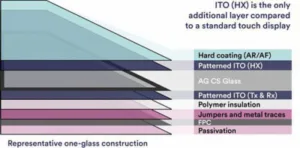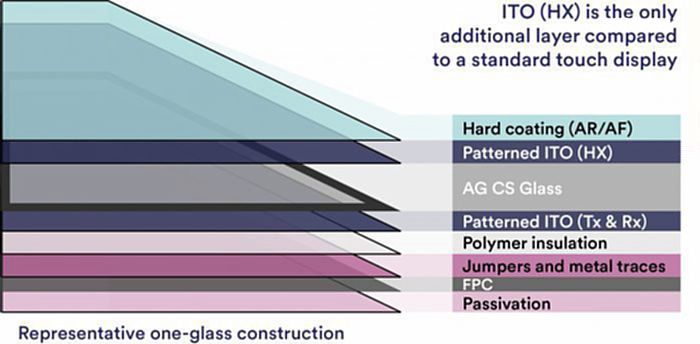A recent press release by Tanvas, Inc. (Chicago, IL), a developer of surface haptic technology, announced the results of a collaboration with “one of the world’s leading display suppliers.” The product of the collaboration is described as a prototype flexible AMOLED display that incorporates advance surface haptic technology.

First, a few words of background information.
Haptics can be defined as “the science and technology of transmitting and understanding information through touch.” Up to now, implementation of haptic capability in display applications has generally been limited to the use of mechanical vibration, an approach called vibrotactile technology. Implementation of vibration-based haptics requires an actuator that physically moves device components. This approach is capable of producing only a limited range of haptic effects. (and may not work so well with flexible substrates – editor)
The surface haptics approach used by Tanvas, the other hand, does not require any moving parts. It is a solid state technology that can simultaneously deliver different types of haptic effects to multiple areas on the same surface. More than that, a surface that incorporates the so-called TanvasTouch version of the technology can not only produce haptic effects but can also receive touch input. The haptic effects can be controlled by a simple program and produces consistent results regardless of the shape or size of the surface. This includes the upper surface of curved and flexible displays.
TanvasTouch technology was originally developed at Northwestern University. An early article describing the technology can be found here. With this technology, haptic effects are achieved by the generation and control of surface friction. The means by which surface friction is generated is called electroadhesion.
Paraphrasing the definition found in Wikipedia: Electroadhesion is the electrostatic effect of astriction (the act of binding or the state of being bound) between two surfaces subjected to an electric field. The electroadhesion effect can be implemented by placing electrodes upon a polymer substrate. When alternate positive and negative charges are applied to adjacent electrodes, the resulting electric field induces opposite charges on the surface of a second material in contact with the polymer substrate. The result is an electrostatic adhesion between the electrodes and the induced charges on the surface of the second material.
Using an approach based on electroadhesion, it is possible to generate distinct regions on the upper surface of a device in which an electric field is present. Such regions would produce greater frictional resistance to a finger slid across the surface of the device than regions without the presence of an electric field. (Think of the finger as a sliding second surface.) By arranging the regions of greater friction in appropriate patterns, a finger slid over the surface can experience haptic effects that include edges, switches and textures that range from smooth to gritty.
One advantage of the TanvasTouch approach is that it uses a surface panel that is built similarly to current touchscreens. Some time ago, Tanvas posted a cross section illustration of an early version of a surface haptic enabled display. It is illustrated in the figure below.
An early implementation of electroadhesion-based surface haptics in a standard display assembly requires only the addition of a patterned ITO layer on the cover glass. The display also includes touch input capability.
The Tanvas team reports having completed several working prototypes. One such prototype is a 12.1 inch flexible AMOLED display. It uses materials slightly different than those pictured in the illustration above. The flexible touch/haptic sensor uses PET polymer films with metal mesh in implementing the touch functions Tx and Rx and ITO in implementing the haptic function Hx. The nature of the haptic feedback, such as its behavior, size and position, can be customized by the use of an associated API (Application Programming Interface).
A brief video illustrating the flexible AMOLED display prototype enabled with Tanvas Touch surface haptic capability can be found in the video appended to the end of this article. A screen shot from the video appears in the photo below.
A flexible AMOLED display enabled with Tanvas Touch surface haptic/touch capability.
The company explains that “the blend of a flexible touchscreen with tactile textures and haptic effects opens creative applications and responsive surfaces in any shape, size or configuration and showcases the technology for commercial use.” -Arthur Berman


